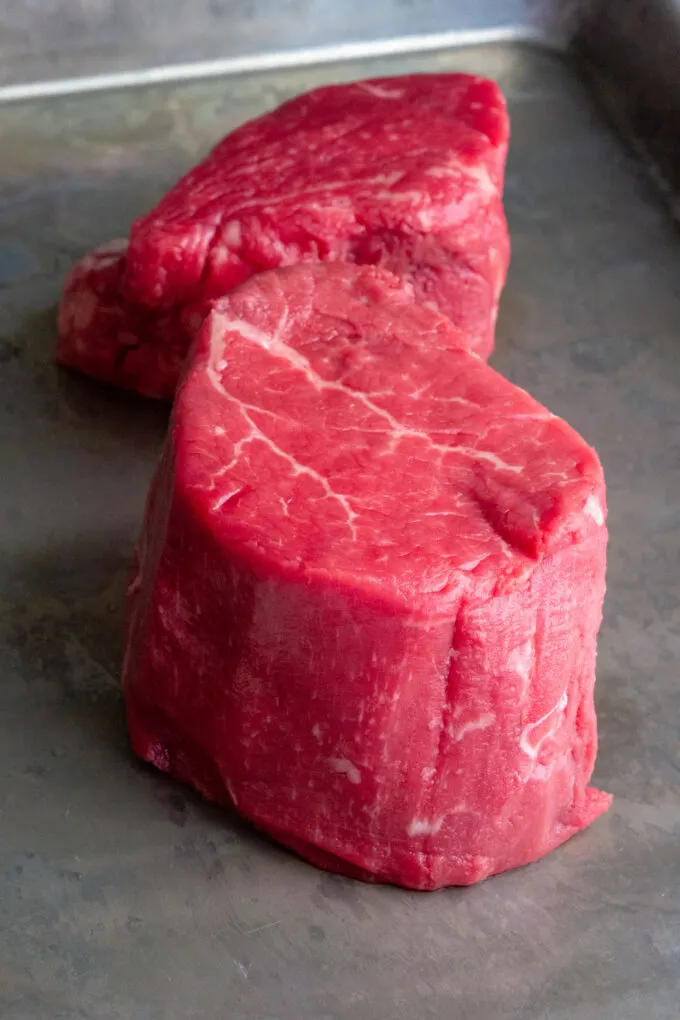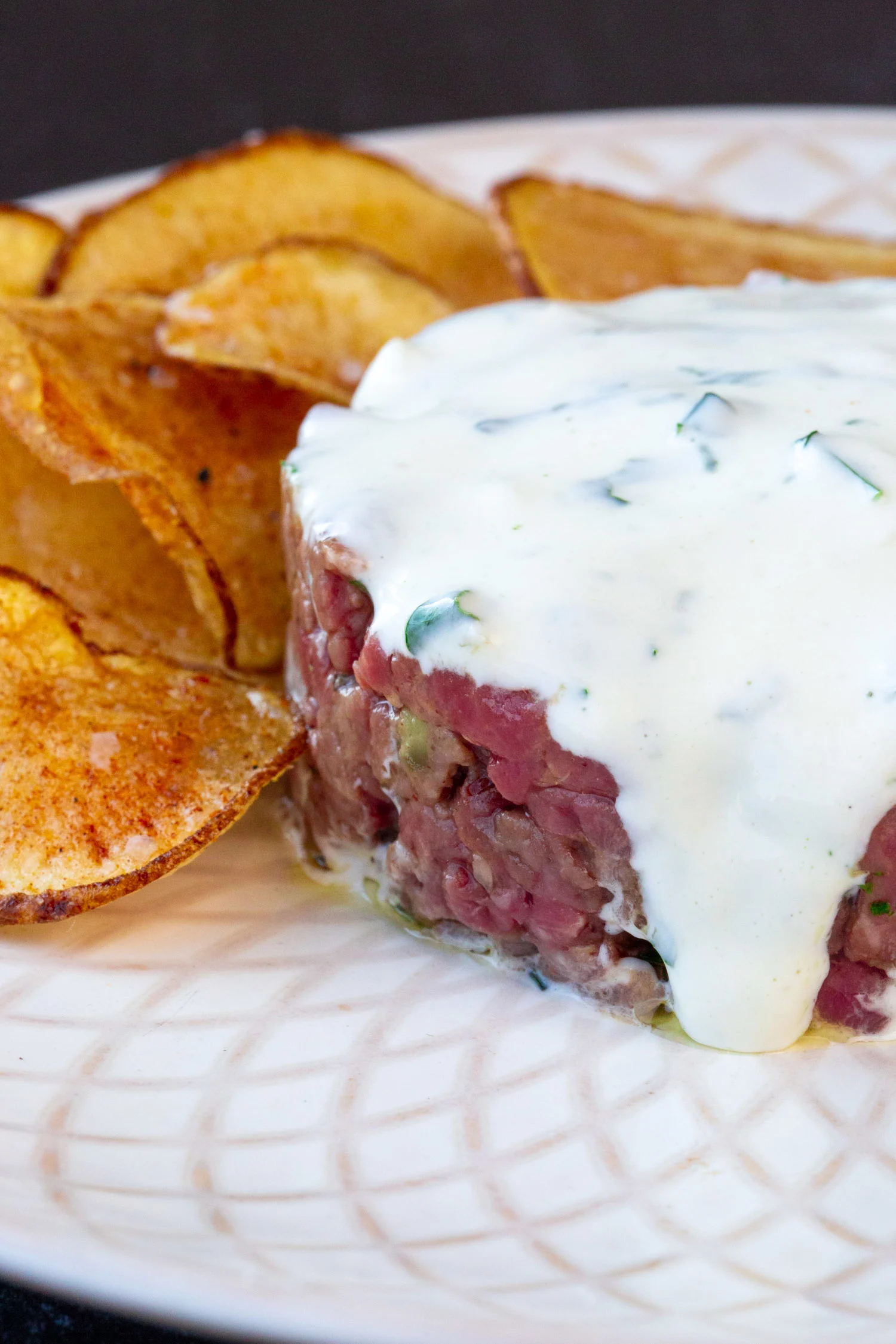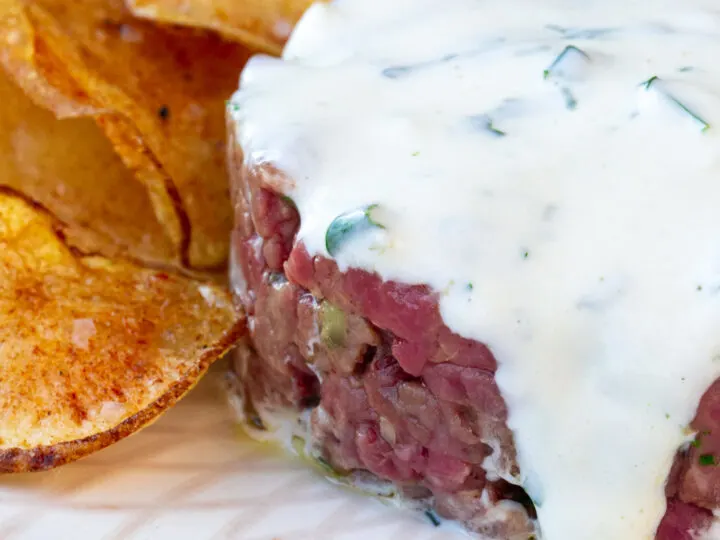Welcome to a food adventure for true beef lovers and the culinary adventurous!
Today we’re going to explore the world of beef tartare, a classic dish that showcases the nuances of excellent quality steak and pairs it with bold ingredients, taking beef and barbecue lovers down an unfamiliar path…the taste of chilled, expertly handled raw beef.

With its origins rooted in French cuisine, beef tartare has captivated chefs and foodies worldwide with its exquisite blend of textures and vibrant flavors.
Crisp shallot, tangy dijon mustard, and briny capers traditionally contrast the chopped beef, but fancy restaurants serve an array of creative versions from Asian-influenced steak tartare using sambal oelek and kecap manis, to southwestern versions with smoky poblano cremas and crisp tortilla chips.
Whether you’re an experienced home cook or a curious epicurean eager to explore new flavors, this beef tartare recipe will surely captivate your senses and leave a lasting impression.
So, gather your culinary courage, sharpen your knives, and prepare for an extraordinary journey into the realm of raw culinary brilliance. Get ready to savor the delicate nuances of beef tartare and embrace the allure of this timeless dish. Let’s begin!
What is Beef Tartare?
Beef Tartare is an elegant dish of coarsely chopped or finely minced raw beef tenderloin combined with shallot, fresh herbs, dijon mustard, and other seasonings eaten on toasted baguette or gaufrettes (a crisp, latticed potato chip).
Although it is served in French bistros and largely considered French, the dish originated in the Baltic region of Russia during the Medieval period. It can be served as an appetizer or dinner offering with numerous versions existing that do not follow the classic recipe, but instead substitute global flavors.


Is Beef Tartare Cooked?
No, beef tartare is not cooked. Beef Tartare is a classic steak dish of high-quality meat prepared under meticulous care to ensure its freshness and quality. Fresh beef filet is kept chilled and in fresh and sanitized conditions from start to finish to reduce the risk of foodborne illness.
Is Beef Tartare Safe?
Beef tartare is not without risks and should be approached with the same caution as raw fish dishes like sushi and raw oysters. It is generally advised that pregnant women, children, senior citizens, and those who may be immunocompromised should avoid beef tartare. This is a personal decision that should be made between you and your physician.
For more safety tips, check out this post on the proper safety observances needed when preparing beef tartare by our resident professional chef, Sarah Penrod.
What Does Beef Tartare Taste Like?
Beef tartare embodies the essence of simplicity and sophistication, transforming the humble raw meat into a sensational culinary masterpiece.
Each bite offers a delightful contrast of tender meat, rich spices, tangy accents, and a hint of earthiness, all expertly balanced to elevate your dining experience.
Beef tartare now comes in many expressions… our version below uses a garlic and lemon aioli paired with the classic french flavors of fresh bright herbs and lemon zest.
Other chefs’ recipes find pops of flavor from red wine vinegar, raw egg yolk, dry mustard, sherry vinegar, and selecting different accompaniments to the ground steak mixture, such as fresh micro greens, endive, and homemade crisps.


How To Make Beef Tartare
The key to a remarkable beef tartare lies in the quality of ingredients and meticulously clean preparation.
Start with the finest cut of beef ensuring its freshness. Chefs reach for a whole piece of meat, such as a lean but succulent beef tenderloin, which is the safest method due to the beef coming from only one animal.
Ground beef should never be used for beef tartar as the meat processing plant can process hundreds of animals in one day, which increases the chance of e. coli contamination. I’ve already written an exhaustive chef’s guide to beef tartar on this post if you would like to learn more.
By selecting a whole piece of beef, like a tenderloin or filet mignon steak, you’re taking the first step in ensuring the best beef selection for food safety.
Next, you’ll want to keep that beef chilled, only transferring it to your sanitized cutting board when you are ready to finely dice it with a very sharp knife.
You’ll then take this chopped steak and place it in a large mixing bowl. Transfer this bowl to the refrigerator to chill while cutting up any seasonings like fresh herbs and shallot.
Fold these ingredients in quickly right before serving. I like to plate it with a large, round cookie cutter, surrounded by the accompaniments at my dinner parties.

Safety Tips For Beef Tartare Include:
- Use freshly washed clean hands
- Sanitizing all surfaces, knives, cutting boards, etc. that you will use when assembling the beef mixture.
- Keep the meat chilled through the entire process
- Only use fresh, bright red beef without odors
- Never use pre-ground beef
- Discard leftovers immediately. Do not save the raw ground steak for a later meal
Tartare of Beef: Differing Versions and Substitutions
- Any lean whole cut of beef without connective tissue can be used but chef prefer small steaks from the beef tenderloin.
- Some chefs make a mound on top of the beef tartare and place raw eggs as an accompaniment. This is a French cooking influence and is optional. (I prefer a sauce on top of mine.)
- Any combination of herbs and aromatics can be used. Experiment with different flavor profiles.
- Accompaniments are used as a vehicle to scoop the homemade steak tartare. Try endive, toast points, potato chips, fine crackers, etc.
Can You Make Wagyu Beef Tartare?
Wagyu beef tartare is a lovely method for appreciating the high fat in wagyu beef. We purchase our wagyu from Snake River Farms and prefer a beef tenderloin or filet mignon as the best cut for the job.

Beef Tartare Recipe
Ingredients
- 2, 8 ounce filet mignon steaks (or any cuts from the beef tenderloin)
- 2 small shallots
- 1 tablespoon diced capers, drained from the brine
- 2 tablespoons fresh chives, minced
- 1 tablespoon dijon mustard
- 1 teaspoon Worcestershire sauce
- 1 teaspoon Tabasco sauce (fresh lemon juice may be substituted)
- 2-3 tablespoons good quality olive oil, to bind the ingredients together
- Kosher salt and freshly cracked black pepper, to taste
Garlic Aioli Sauce:
- 1/4 c. mayonnaise
- 1 garlic clove
- 1 t. fresh lemon juice
- 1 pinch salt
Accompaniments:
- Thin crisp toasted baguette slices, toast points, lightly salted potato chips, celery leaves
Instructions
For the Beef Tartare:
With a freshly washed and sanitized cutting board and knife, slice the fresh beef into thin slices and then again into thin strips. Line up all the strips and dice the meat into as finely ground bits as you can cut. Transfer the chopped raw meat into a large bowl.
Clean the cutting board and knife well and prepare to chop the flavoring ingredients.
Drain 1 tablespoon of capers and finely dice them, add to the fresh meat.
For the two shallots, remove the skin and dice them into small pieces. (Everything should be chopped as small as possible to create classic beef tartare.) Add the shallot to the raw beef.
Next, line up the chives and mince them as fine as possible. Add to the small bowl with everything else.
Now add in the dijon mustard, Worcestershire sauce, and Tabasco hot pepper sauce. (If you don't like spice, just substitute lemon juice.)
Stir well and finely add the olive oil, just enough to bind the ingredients, provide moisture, and get them to hold a good shape for presentation. The desired consistency may vary for different cooks.
Season with salt and pepper. Start with 1 teaspoon salt and add more to taste.
For the Aioli:
In a small bowl combine the mayonnaise, lemon juice, pinch of salt. Press the garlic through a garlic press or mince finely and add to the aioli. Stir well and taste for seasoning.
Chill until ready to use. This sauce is best if it is allowed to develop over several hours or overnight.
Notes
Do not keep leftovers for food safety reasons. Consult with your doctor about whether it is safe to enjoy raw or undercooked beef for you and your family.
Nutrition Information:
Yield:
4Serving Size:
1Amount Per Serving: Calories: 623Total Fat: 45gSaturated Fat: 11gTrans Fat: 0gUnsaturated Fat: 30gCholesterol: 116mgSodium: 623mgCarbohydrates: 20gFiber: 2gSugar: 3gProtein: 33g
This nutritional information is provided as a courtesy as an estimate only. Consult with a dietician for precise estimates. This website makes no claims that the nutritional values listed are accurate.



Sharon
Saturday 13th of January 2024
Thank you so much for this. My husband and I have always wanted to try this but haven't ever had the guts to. It was wonderful and my husband loved it!